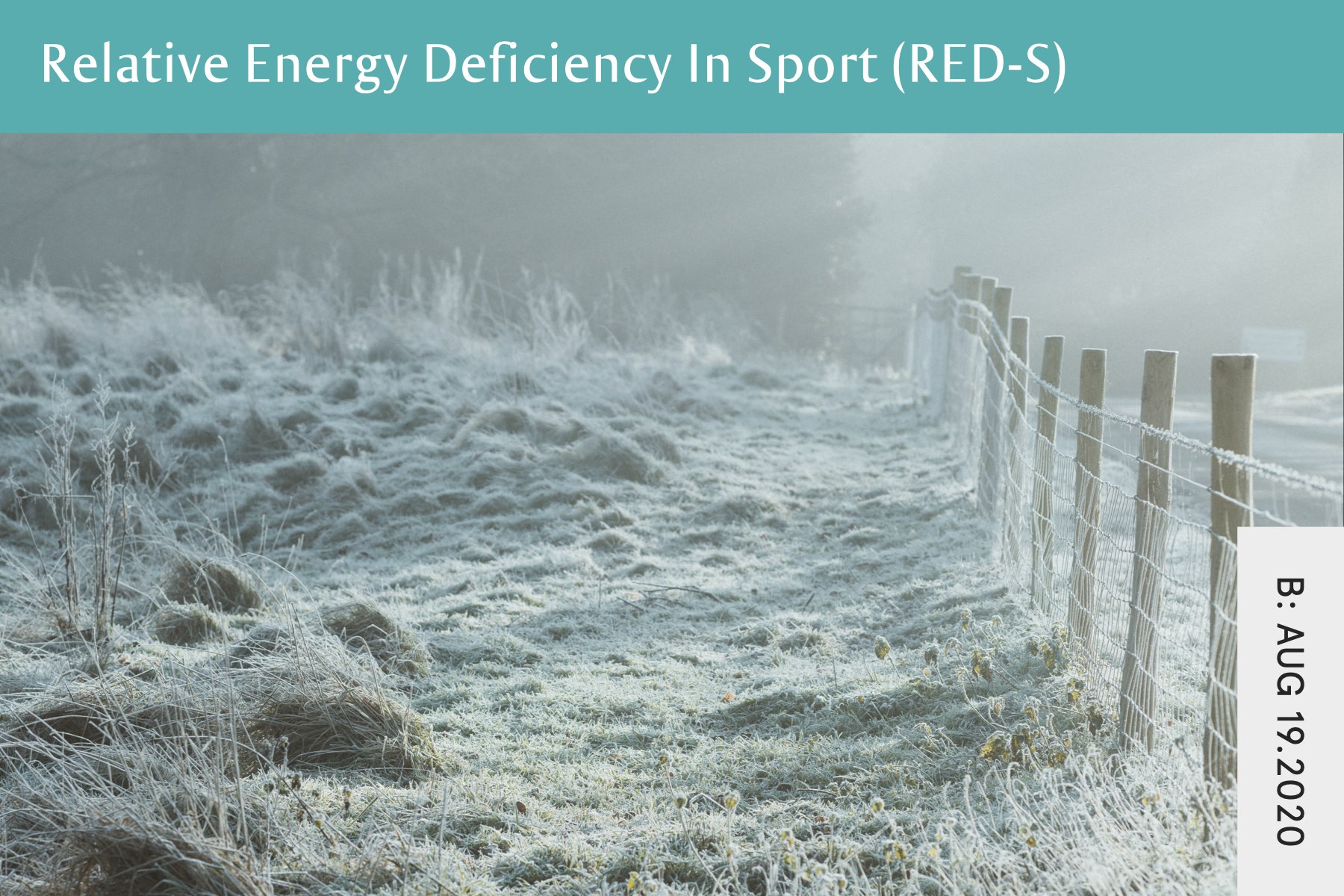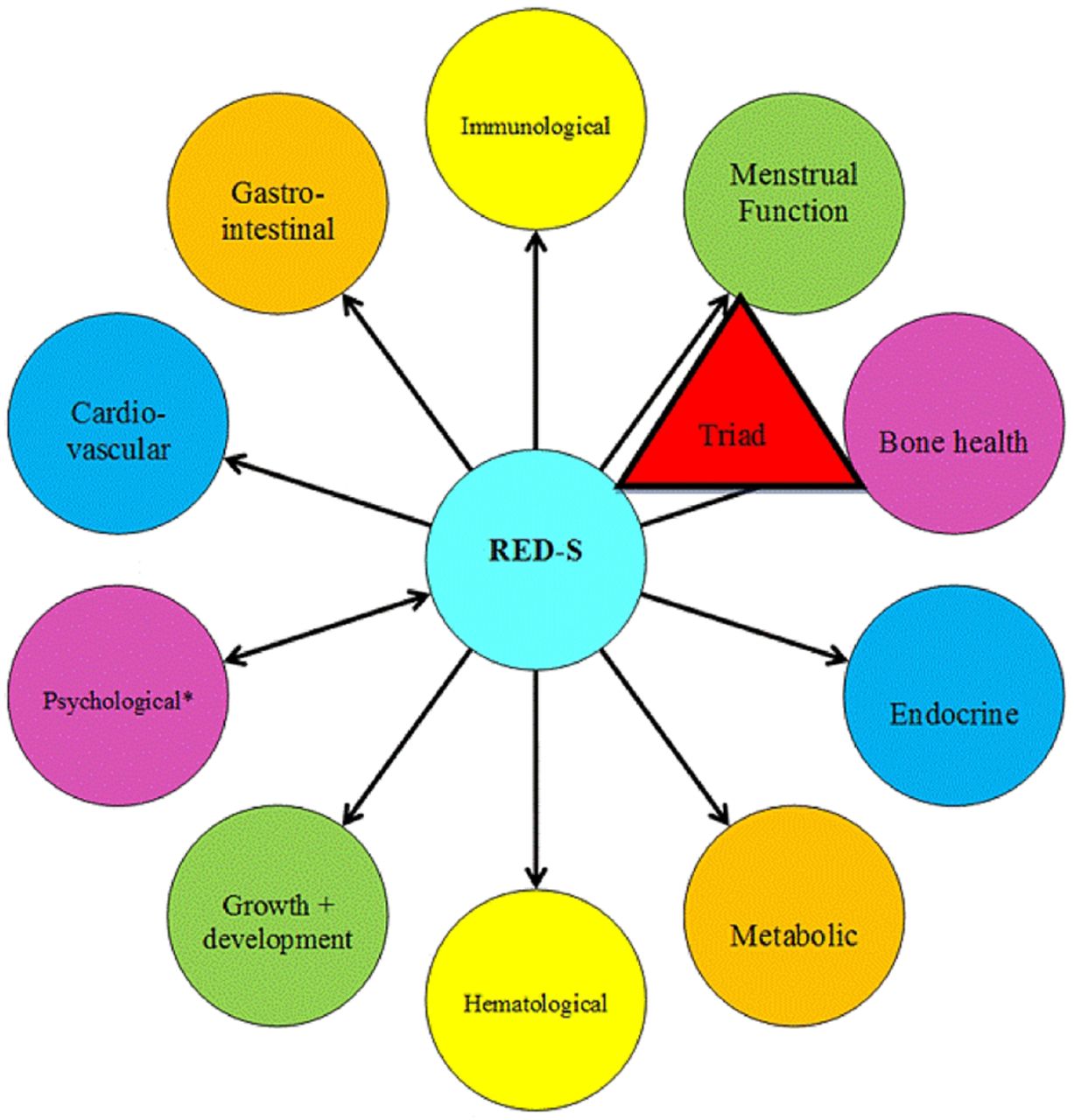

In recent years I’ve seen an increased awareness of the condition relative energy deficiency in sport or RED-S. The term was coined in 2014 and since then has risen in prominence.
But despite this growing awareness, I’m not sure it has reached the masses. And given how many people are exercising in a way that is compulsive and creating negative symptoms, I think it is worth exploring.
Relative energy deficiency in sport is a term that was created to replace the female athlete triad.
The female athlete triad is a combination of three symptoms:
The female athlete triad was a term that came into use back in 1992, but there was much debate about the components and how they were interconnected. It was then in 2005 that the International Olympic Committee (IOC) put out a consensus statement, giving the condition more exposure.
But after 2005, as the IOC continued its research, they noticed there were a couple of issues with the name.
Firstly, at the core of the condition is energy deficiency. There isn’t enough energy to match up to someone’s sporting activities plus daily living, growth and repair (namely, being a human being).
And this would affect all people, rather than just females. Men were suffering too.
Secondly, this was about more than just bones and menstruation. The deficiency was having an impact on metabolic rate, immunity, cardiovascular health, psychological health, digestion, etc. The image below clearly demonstrates this, and it’s something I cover at length in this podcast).

Via BMJ: https://bjsm.bmj.com/content/48/7/491
It means that this isn’t a triad, but is body-wide and affecting all systems of the body.
So, based on this increased understanding, the IOC released a consensus statement in 2014 updating the term female athlete triad to relative energy deficiency in sport or RED-S.
One of the stumbling blocks with RED-S is the narrow belief about who it can affect.
The condition has the word “sport” in its title.
The previous term that it replaced had “athlete” in its title.
The name RED-S was coined by the “International Olympic Committee”.
All of this can make it feel like this is something that only affects real athletes. You know, people who do their chosen sport for a living.
But this is simply not true. RED-S can affect anyone who is training, where this training is not being met with sufficient calories to match up with the demands placed on the body.
And while I do think RED-S is rampant in professional sport, it is equally a problem for those who wouldn’t ever use the word athlete to describe themselves.
So, if you think that you only run three times a week or that rock climbing is your hobby and this couldn’t possibly be an issue, think again.
Below is a non-exhaustive list of some of the most common symptoms of RED-S.
In reality, the list of possible symptoms is much longer than this. Pick any of the circles from the previous image, think about what happens when this system receives insufficient energy and the resulting symptom can be connected to RED-S.
Insufficient energy availability is a problem irrespective of whether the cause is disordered eating, an eating disorder or simply not knowing you require extra energy.
And this last option, the not knowing, is incredibly common. Which is true for those participating in the sport and for those giving advice (like doctors, nutritionists, or personal trainers).
I’ve seen many clients over the years who were clearly suffering from symptoms connected to RED-S. Sometimes it was a sole overriding symptom, like intense exhaustion. Other times it was a combination of things – they were getting regular injuries, having trouble sleeping, digestion was getting worse and their period had stopped.
But when seeing their doctor and explaining their symptoms, not once was their level of eating or exercise questioned. If anything, they were praised for being “healthy”.
Or, if they happened to be living in a larger body, their symptoms were blamed on insufficient exercise and too many calories.
Same thing if they saw a nutritionist. Rather than identifying that calories were too low for the amount they were training, the focus was on doing an elimination diet, working on detoxification or cutting out sugar.
Or again, if they were in a larger body, weight loss was suggested as the answer to their problems.
We live in a world where we have this misguided understanding of what it means to be fit and healthy. And this is true whether we are talking about doctors and those who hold a PhD in nutrition through to the Instagram influencers who have no training but are beautiful and know a thing or two about marketing.
Society praises physical endurance. It lusts after strength and muscles. It holds in high esteem fasting and weight loss transformations. Every aspect of what makes RED-S the most likely outcome is converted instead of discouraged.
While energy deficiency is at the core of the condition and therefore should be included in the name, I think this can be misleading.
As I said a moment ago, for many people, they are unaware of the calories that are needed. And, rarely, is this pointed out.
But even when they do become enlightened to what is happening and the damage being caused, real change fails to occur.
Part of this is because of sheer disbelief. That this information runs so counter to everything they have heard.
But the bigger part is because it’s a deeper issue than just not knowing. It’s disordered eating or an eating disorder and there are problems and fears lurking below the surface that need to be dealt with. Issues like:
Fear of weight gain
Fear of losing their identity
Fear of becoming “unfit”
Fear of certain foods
Fear of judgement
Not having coping skills outside of using food restriction and exercise
Not knowing how to fill their time outside of exercise
Underlying issues like anxiety, depression or low self-esteem
The mismatch between energy in versus energy out is a symptom; the real driver is a psychological component of disordered eating or an eating disorder. And if the focus is only on the energy deficiency part, improvements are unlikely to get very far.
You’ll attempt to up your calories, but only allow the absolute minimum amount of increased food to get out of the energy-deficient state.
You’ll reduce exercise, but again, by the smallest amount you think could lead to the cancelling of the debt.
You’ll change what you eat in the most fractional way too. If you can keep to your regular safe foods and simply increase the quantity of some of them, you will.
Rather than a total shift in how you relate to exercise, food and life so you can leave this behind forever; the focus is on small tweaks that allow you to keep doing what you’ve always done, but with you now taking in a bit more energy. The goal becomes to not “overdo” recovery and basically keep the status quo.
Which is a reliable recipe for quasi recovery, but rarely (if ever) leads to full recovery.
I’m not against exercise; I believe it can be incredibly important for health. But as I cover here and here, we need to change how we think about exercise.
Exercise in and of itself isn’t healthy. What makes it so is adequate rest and energy availability so the body can appropriately adapt. Without this, exercise is simply a stress on the body. And in the area of RED-S, a stress that is leading to a myriad of symptoms.
If you are someone who is exercising and knows that it’s not supporting your health, I’d love to help. Same thing if this article has been an awakening with lots of new information to take in.
Through working together we can address the issue of low energy availability plus the deeper issues that are creating the problem in the first place.
I’m a leading expert and advocate for full recovery. I’ve been working with clients for over 15 years and understand what needs to happen to recover.
I truly believe that you can reach a place where the eating disorder is a thing of the past and I want to help you get there. If you want to fully recover and drastically increase the quality of your life, I’d love to help.
Want to get a FREE online course created specifically for those wanting full recovery? Discover the first 5 steps to take in your eating disorder recovery. This course shows you how to take action and the exact step-by-step process. To get instant access, click the button below.
Share
Facebook
Twitter